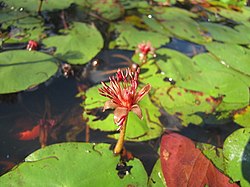| Cabombaceae Temporal range: (likely) Mid-Cretaceous–Present | |
|---|---|
 | |
| Flowering Cabomba caroliniana | |
 | |
| Flowering Brasenia schreberi | |
| Scientific classification | |
| Kingdom: | Plantae |
| Clade: | Tracheophytes |
| Clade: | Angiosperms |
| Order: | Nymphaeales |
| Family: | Cabombaceae Rich. ex A.Rich. [1] |
| Type genus | |
| Cabomba Aubl. [2] | |
| Genera | |
| |
| Synonyms | |
The Cabombaceae are a family of aquatic, herbaceous flowering plants. A common name for its species is water shield. [6] The family is recognised as distinct in the Angiosperm Phylogeny Group IV system (2016). The family consists of two genera of aquatic plants, Brasenia and Cabomba , totalling six species. [7]
